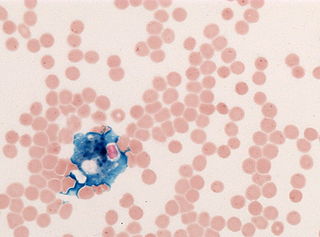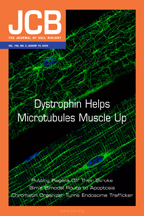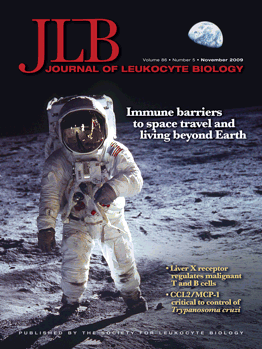
Romanowsky staining, also known as Romanowsky–Giemsa staining, is a prototypical staining technique that was the forerunner of several distinct but similar stains widely used in hematology and cytopathology. Romanowsky-type stains are used to differentiate cells for microscopic examination in pathological specimens, especially blood and bone marrow films, and to detect parasites such as malaria within the blood. Stains that are related to or derived from the Romanowsky-type stains include Giemsa, Jenner, Wright, Field, May–Grünwald and Leishman stains. The staining technique is named after the Russian physician Dmitri Leonidovich Romanowsky (1861–1921), who was one of the first to recognize its potential for use as a blood stain.

Moshe Wolman was an Israeli neuropathologist. He is considered one of the fathers of histochemistry. In 1954, he described Wolman's disease.

Neuromelanin (NM) is a dark pigment found in the brain which is structurally related to melanin. It is a polymer of 5,6-dihydroxyindole monomers. Neuromelanin is found in large quantities in catecholaminergic cells of the substantia nigra pars compacta and locus coeruleus, giving a dark color to the structures.

Phosphotungstic acid (PTA) or tungstophosphoric acid (TPA), is a heteropoly acid with the chemical formula H3PW12O40]. It forms hydrates H3[PW12O40]·nH2O. It is normally isolated as the n = 24 hydrate but can be desiccated to the hexahydrate (n = 6). EPTA is the name of ethanolic phosphotungstic acid, its alcohol solution used in biology. It has the appearance of small, colorless-grayish or slightly yellow-green crystals, with melting point 89 °C (24 H2O hydrate). It is odorless and soluble in water (200 g/100 ml). It is not especially toxic, but is a mild acidic irritant. The compound is known by a variety of names and acronyms (see 'other names' section of infobox).

The Biochemical Journal is a peer-reviewed scientific journal which covers all aspects of biochemistry, as well as cell and molecular biology. It is published by Portland Press and was established in 1906.
The Journal of the Royal Society of Medicine is a peer-reviewed medical journal. It is the flagship journal of the Royal Society of Medicine with full editorial independence. Its continuous publication history dates back to 1809. Since July 2005 the editor-in-chief is Kamran Abbasi, who succeeded Robin Fox who was editor for almost 10 years.

Virology is a peer-reviewed scientific journal in virology. Established in 1955 by George Hirst, Lindsay Black and Salvador Luria, it is the earliest English-only journal to specialize in the field. The journal covers basic research into viruses affecting animals, plants, bacteria and fungi, including their molecular biology, structure, assembly, pathogenesis, immunity, interactions with the host cell, evolution and ecology. Molecular aspects of control and prevention are also covered, as well as viral vectors and gene therapy, but clinical virology is excluded. As of 2013, the journal is published fortnightly by Elsevier.
The Journal of Cell Science is a peer-reviewed scientific journal in the field of cell biology. The journal is published by The Company of Biologists. The journal is partnered with Publons, is part of the Review Commons initiative and has two-way integration with bioRxiv. Journal of Cell Science is a hybrid journal and publishes 24 issues a year. Content over 6 months old is free to read.

In histology, histopathology, and clinical pathology, Perls Prussian blue is a commonly used method to detect the presence of iron in tissue or cell samples. Perls Prussian Blue derives its name from the German pathologist Max Perls (1843–1881), who described the technique in 1867. The method does not involve the application of a dye, but rather causes the pigment Prussian blue to form directly within the tissue. The method stains mostly iron in the ferric state which includes ferritin and hemosiderin, rather than iron in the ferrous state.
György Gömöri was a Hungarian-American physician who became famous as a histochemist.

The Journal of Cell Biology is a peer-reviewed scientific journal published by Rockefeller University Press.
Biotechnic & Histochemistry is a peer-reviewed scientific journal that covers all aspects of histochemistry and microtechnic in the biological sciences from botany to cell biology to medicine. It is published by Taylor & Francis on behalf of the Biological Stain Commission. The journal was established in 1926 as Stain Technology by Harold J. Conn. It obtained its current title in 1991. The editor-in-chief is G. S. Nettleton.

The Journal of Leukocyte Biology is a monthly peer-reviewed medical journal covering all aspects of immunology. The focus of the journal is on leukocyte physiology and leukocyte behavior within the immune system. Content is available for free after a 12-month embargo. Since 2009, the editor-in-chief has been Luis J. Montaner. The journal is published by the Society for Leukocyte Biology.

Cephalalgia: An International Journal of Headache is a peer-reviewed medical journal covering research on headache. It is published by SAGE Publications on behalf of the International Headache Society; it was previously published by Blackwell Publishing. The journal was established in 1981 and currently has 16 issues per year. The editor-in-chief is Arne May.
The Biological Stain Commission (BSC) is an organization that provides third-party testing and certification of dyes and a few other compounds that are used to enhance contrast in specimens examined in biological and medical laboratories.
The Histochemical Society (HCS) is an academic society that was founded on March 24, 1950 at a meeting organized by Ralph D. Lillie of the National Institutes of Health. The idea for the Society arose during the 1949 Biological Stain Commission meeting at which a symposia encompassing anatomy, cytology, pathology and biochemistry was proposed by Lillie, Charles Leblond and Edward Dempsey. Lillie became the first editor of HCS's journal, Journal of Histochemistry and Cytochemistry.
Alex Benjamin Novikoff was a Russian Empire-born American biologist who is recognized for his pioneering works in the discoveries of cell organelles. A victim of American Cold War antagonism to communism that he supported, he is also recognized as a public figure of the mid-20th century at the height of McCarthyism in America. As his original discoveries such as cell organelles and autophagy earned other scientists Nobel Prizes, he is regarded as one of the overlooked scientists to get Nobel Prize.
The Journal of Molecular Endocrinology is a peer-reviewed scientific journal published eight times per year. Its focus is on molecular and cellular mechanisms in endocrinology, including gene regulation, cell biology, signalling, mutations and transgenesis.

Public Health Reports is a peer-reviewed public health journal established in 1878 and published by SAGE Publishing for the Association of Schools and Programs of Public Health and the United States Public Health Service. The title and publication frequency of the journal has varied over the years, but it is currently published bimonthly. The editor-in-chief is Hazel D. Dean. Articles are published under a delayed open access, where they become fully open access one year after publication. Some special articles are published as open access including regularly published commentaries by the US Surgeon General and other top United States Department of Health and Human Services officials.
Jerome Gross was an American biologist and member of the National Academy of Sciences. His research at Harvard Medical School and the Massachusetts General Hospital in the 1950s helped launch the fields of collagen research.











